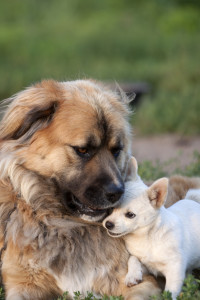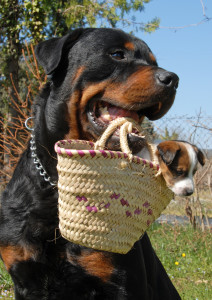Dangers of Play Between Large and Small Dogs
Here are three dangers of having dogs of vastly different sizes play together in an off-leash environment.We know this policy is controversial. Many pet care professionals will disagree saying large dogs often play well with small dogs, some small dogs are feisty and need a larger dog for play, or that this type of separation policy is a hardship for owners with different sized dogs in the same household. There is truth in these statements. But this does not negate the fact that a dog owner is paying for a pet professional to take the best care of their pet. We think the bar of safety is significantly higher when dogs are separated based on size as well as by temperament and playstyle.
- Small dogs can get injured quickly by a group of large dogs playing. – Large dogs cannot always move out of the way of small dogs who might be running in the play area. And not every tiny dog is aware enough to move out of the way of two large dogs rolling on the ground wrestling. Dogs of different sizes are likely to get in each other’s space more easily when they run to the gate to see a dog entering or leaving the playgroup. While it’s nice to believe that every large dog will handicap his behavior to accommodate the small dog, it just doesn’t always happen. The small dog is at risk of injury and the larger the dogs he is with, the greater that potential.
- Small dogs can look like prey. It’s a sad reality but one we have to face as pet care professionals. Last week we talked about prey-drive. Dogs that like to chase things may mistakenly chase a smaller dog just because, from a distance, the small dog looks like something that should be chased. This is particularly true in a play area where dogs get riled up and run around quite a bit. Some dogs will chase one another during routine play, others will chase a ball, other dogs just like the fun of running. But when a small dog begins these fast moving activities, it’s possible to trigger a large dog into a predatory chase. If this happens, it’s possible for a bite to occur when the large dog catches up with the smaller dog. The small dog is at risk of injury.
- In the event that there is a bite or fight incident, a large dog can do significant damage to a small dog. It’s not that dogs of the same size can’t hurt one another, but we rarely get calls that a 70 pound dog killed another 70 pound dog. We hear about the 70 pound dog who killed a 10 pound dog. Dogs of all sizes can fight and bite. But when the dogs are two different sizes, the large dog has an advantage in a fight or bite. The small dog is at a much higher risk of injury.
We recognize that there are gray areas in this policy to separate large and small dogs.
- There are some dogs that are small but tenacious. They seem too active to be with other small dogs. And there are some big dogs that are calm and don’t do well with all the high energy of large dogs. It seems better to put them with the tiny dogs.
These are areas where decisions have to be made about how to handle the situation when a dog doesn’t fit into a particular group (whether due to size of the play area, size of the dog, type of playstyle, etc). You might decide to make an exception and put large and small dogs together. We only ask that you recognize that these exceptions come with risks. The fact that gray areas exist does not nullify the truth: small dogs are more easily injured playing in the big dog area.














Nhận xét
Đăng nhận xét